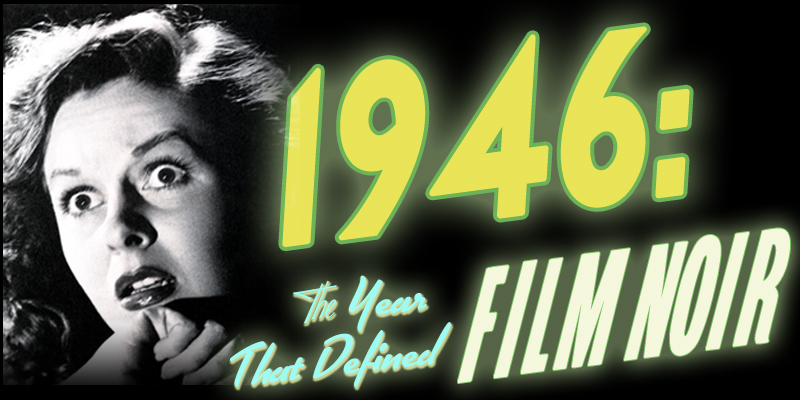
NOIR LINKS
10 Shades Of Noir
Back Alley Noir
Classic Noir Online
Dr. Noir's Crime Posters
AMC Film Noir
Film Noir Foundation
The Dark Room
Noir of the Week
Noircast.net
Film Noir Alley
Noir City
IMDb
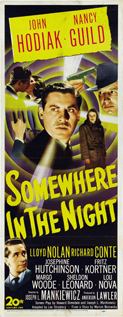 Somewhere In The Night is an archetypal film noir in many respects - it has one of the most complex and labyrinthine plots of the cycle, and its
protagonist most fully embodies the shattered, amnesiac war veteran figure that was stalking across cinema screens with increasing frequency in 1946.
Somewhere In The Night is an archetypal film noir in many respects - it has one of the most complex and labyrinthine plots of the cycle, and its
protagonist most fully embodies the shattered, amnesiac war veteran figure that was stalking across cinema screens with increasing frequency in 1946.
Opening shots alight on "George Taylor," a Marine who has landed in an Okinawa field hospital after receiving grievous wounds from falling on a grenade.
Though his wallet and personal belongings identify him as "Taylor," he has absolutely no recollection of who he is or how he ended up in his reduced state.
After a long recuperation and several reconstructive surgeries, "Taylor" is coldly processed out of military service and let loose in post-war Los Angeles, with
only his service record and a cryptic letter among his belongings from a "Larry Cravat" to anchor his identity.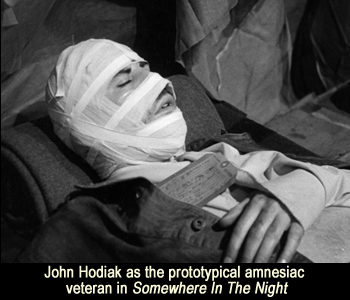
Following up information in the letter leads Taylor to several locations including a bank, a steam bath, and a seedy hotel, where he rapidly attracts suspicion and
the attention of thugs when he enquires about the whereabouts of Cravat. Desperate to establish the truth about his identity and convinced that many
of the assorted riff-raff that he encounters have something to hide, Taylor plunges deeper into a sinister night-world where names, personas, and roles are not
fixed but contingent and subject to the dictates of unknown forces.
Most of the figures that Taylor encounters are either malevolent or pathetic grotesques, such as the crew of thugs led by Anzelmo, a criminal European fortune-teller, who
lay a severe beating on him trying to extract information about Cravat, or the lonely spinster who delivers one of the saddest and most poignant speeches in film noir about
the coldness of fate and time when Taylor contacts her in the pursuit of his investigation.
Taylor eventually earns the trust of a third-rate nightclub singer as well as the interest of a police detective, and it is gradually revealed that Cravat and
likely he himself are implicated in a botched heist of a shipment of Nazi loot that went missing several years earlier, at the same time that Cravat vanished and Taylor enlisted in the Marines.
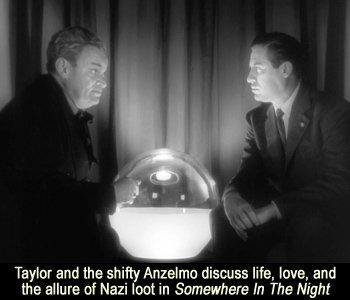 Pursuing the dubious information furnished by Anzelmo and other leads, Taylor's quest winds up with the discovery of the missing Nazi treasure and also the secret
of his own identity beneath the pilings of "Terminal Pier" in San Pedro. Taylor, it turns out, is Larry Cravat, a former private detective who stashed the loot beneath the pier after double-crossing
the intended recipient, a duplicitous and slippery L.A. nightclub tycoon. As Cravat had been mistakenly implicated in a killing that resulted from the abortive money transfer, he was forced into
assuming the identity of Taylor and disappearing into the military to avoid detection and prosecution.
Pursuing the dubious information furnished by Anzelmo and other leads, Taylor's quest winds up with the discovery of the missing Nazi treasure and also the secret
of his own identity beneath the pilings of "Terminal Pier" in San Pedro. Taylor, it turns out, is Larry Cravat, a former private detective who stashed the loot beneath the pier after double-crossing
the intended recipient, a duplicitous and slippery L.A. nightclub tycoon. As Cravat had been mistakenly implicated in a killing that resulted from the abortive money transfer, he was forced into
assuming the identity of Taylor and disappearing into the military to avoid detection and prosecution.
Regardless of its tortuous plot elements, Somewhere In The Night contains some of the most elliptical but evocative depictions of the chaotic and disordered noir universe.
The amnesia and uncertainty of identity exhibited by Hodiak's Taylor/Cravat are met by diluted echoes of his condition in virtually everyone he meets in the course of his quest, save for
his ally the nightclub singer Christy Smith, or police detective Donald Kendall, who ineffectually represent the forces of order and normalcy. The remaining figures in
Somewhere In The Night adopt and discard synthetic existential disguises and masks according to a variety of nefarious compulsions, most of them involving varying degrees of greed.
And with few daylight shots scattered through the film, the Los Angeles as depicted in Somewhere In The Night takes on the cast of a city of ghostly, nameless wraiths, its inhabitants differing little in kind from the beaten-down souls
who slump lifelessly at the Terminal Pier mission house scene on the San Pedro docks.
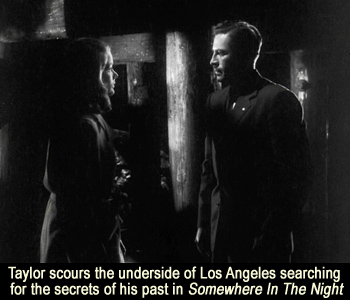 The film's resolution - George Taylor's uncovering of his true identity -
also takes place in a symbolically appropriate location: literally underground, beneath the surface of the city. A visual correlative to the process of
plumbing the hidden unconscious for the keys to one's true nature that is a basic tenet of Freudian psychology, such scenes also became a common element in the visual
syntax of film noir in ensuing years, with key sequences in films such as The Third Man (1949), He Walked By Night (1948) and Panic In The Streets (1950) all depicting
characters roaming sewers or otherwise underground urban locations.
The film's resolution - George Taylor's uncovering of his true identity -
also takes place in a symbolically appropriate location: literally underground, beneath the surface of the city. A visual correlative to the process of
plumbing the hidden unconscious for the keys to one's true nature that is a basic tenet of Freudian psychology, such scenes also became a common element in the visual
syntax of film noir in ensuing years, with key sequences in films such as The Third Man (1949), He Walked By Night (1948) and Panic In The Streets (1950) all depicting
characters roaming sewers or otherwise underground urban locations.